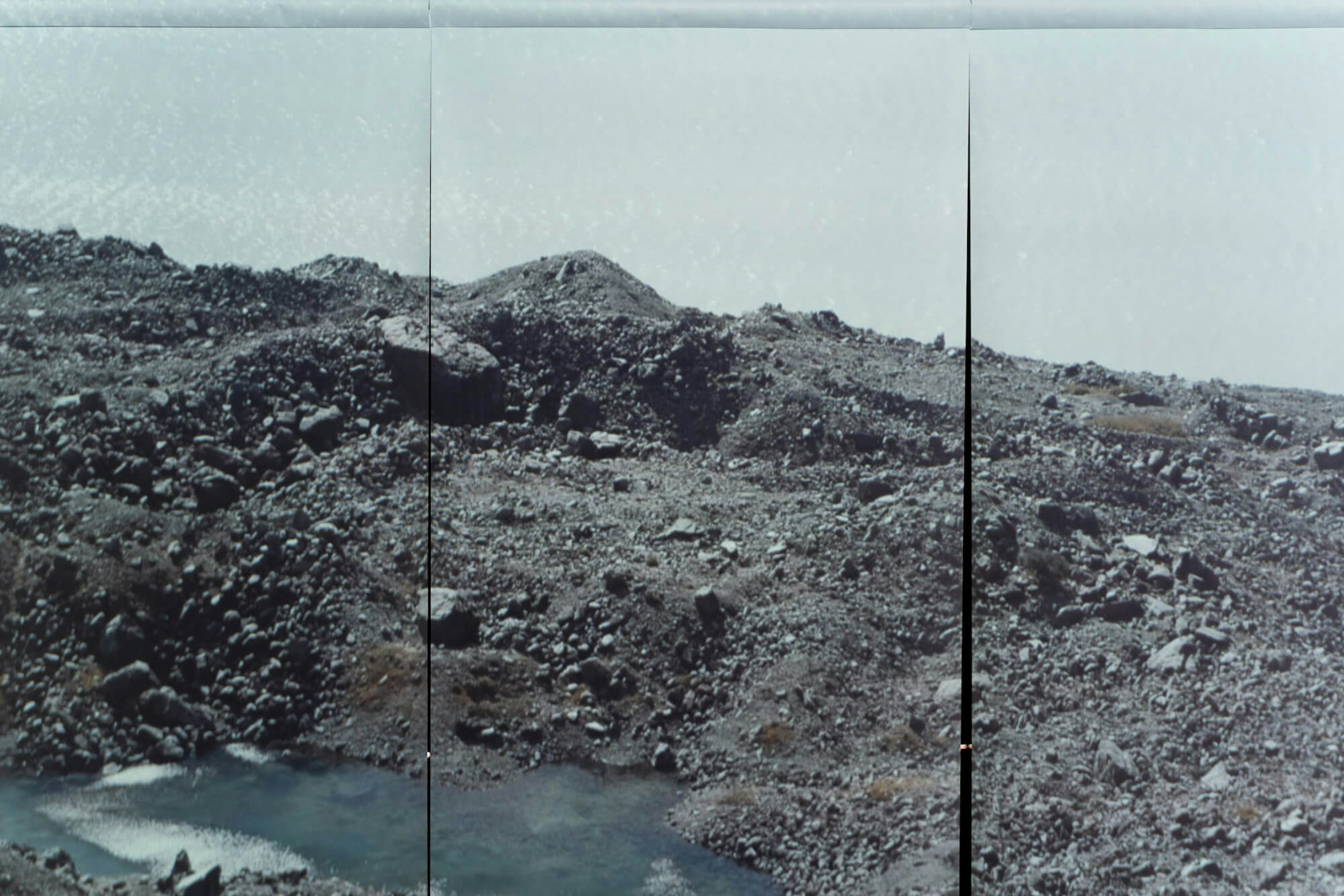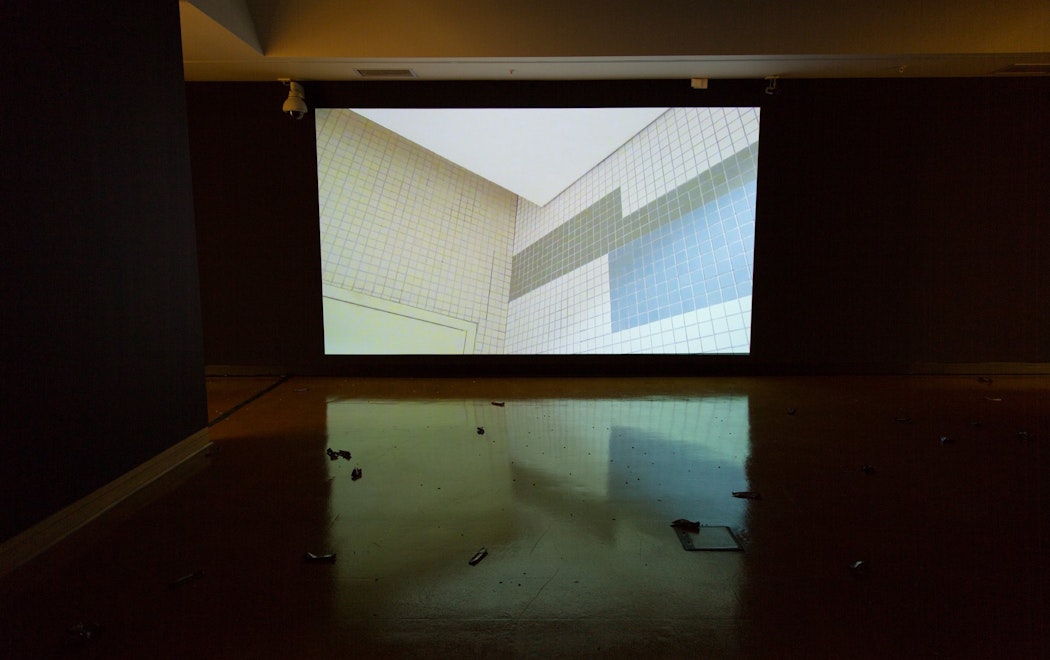An acknowledgment
Ko tēnei tāku mihi ki ka mana whenua o te rohe nei. Ka mihi hoki au ki ka tohu o te rohe nei. Ka mihi ki te ātua Aoraki, sharp, glistening cloud piercer. Ka mihi ki a hukapo Haupapa, to the Haupapa glacier me te awa Haupapa, and to the geologically young Haupapa lake. Ka mihi nui ki te ātua Tāwhirimātea, the ancestral presence of the winds, me mākū, and the changing dispositions of wai, who register as humidity, water droplets, huka or snow, and hukapapa, great snowfields.
Ko tēnei tāku mihi ki ka tākata toi: Ron Bull o Kāi Tahu, Kāti Māmoe, Waitaha, Stefan Marks, Janine Randerson, Rachel Shearer o Rongowhakaata, Te Aitanga a Māhaki, Pākehā, and kaimātai pūtaiao or scientist, the glaciologist Heather Purdie.
Installation view, Ron Bull, Stefan Marks, Janine Randerson, Rachel Shearer, Heather Purdie, Ngā raraunga o te Mākū: te hā o Haupapa, timelapse video 1:48 (2023). Two-channel video, four-channel audio, custom software, live data feed courtesy of NIWA Taihoro Nukurangi, paper, recycled aluminium.
A shard
A key discussion point across diverse Anthropocene and new materialist disciplines—one that will perhaps become less relevant in an unfolding worst-case scenario—concerns the ability to apprehend overall climate instability as more than a series of "unprecedented" weather events. In the frequently overlapping contexts of filmic and contemporary art practices, the manifestation of this slow-moving apprehension is first and foremostly a visual one, with sound as a complementary or an elevated, adjacent medium. Filmmakers and artists engaging with elemental-geological beings such as British artist Katie Paterson with Iceland’s Vatnajökull polar cap and glacier, often seek to incorporate the voice or presence of the being, thereby signalling an attribution of sentience, to varying extents. In her work with Vatnajökull in 2007, Paterson installed a microphone inside Vatnajökull, connected to a phone that people could call to listen to the clanking sounds of ice colliding with ice and breaking apart.(1) In 2007, the emission of atmospheric carbon dioxide was 383.37ppm CO2.(2)
On 18 August 2019, at a carbon dioxide density of 415ppm CO2, mourners gathered at the site of an un-glacier, Okjökull, also known as "Ok" and also in Iceland, to unveil a copper plaque.(3) Although other glaciers had ceased to meet the criteria for “glacier” worldwide, Okjökull was the first in Iceland to dissipate, and quite possibly the first to be publicly mourned and officially memorialised. Written by Icelandic author Andri Snaer Magnason, the raised copper inscription reads, "A letter to the future":
Ok is the first Icelandic glacier to lose its status as a glacier.
In the next 200 years all our glaciers are expected to follow the same path.
This monument is to acknowledge that we know what is happening and what needs to be done.
Only you will know if we did it.(4)
Oddur Sigurdsson, an Icelandic glaciologist who has been monitoring Iceland’s glaciers for fifty years, said, "The glacier was not moving—it was not thick enough to stay alive."(5)
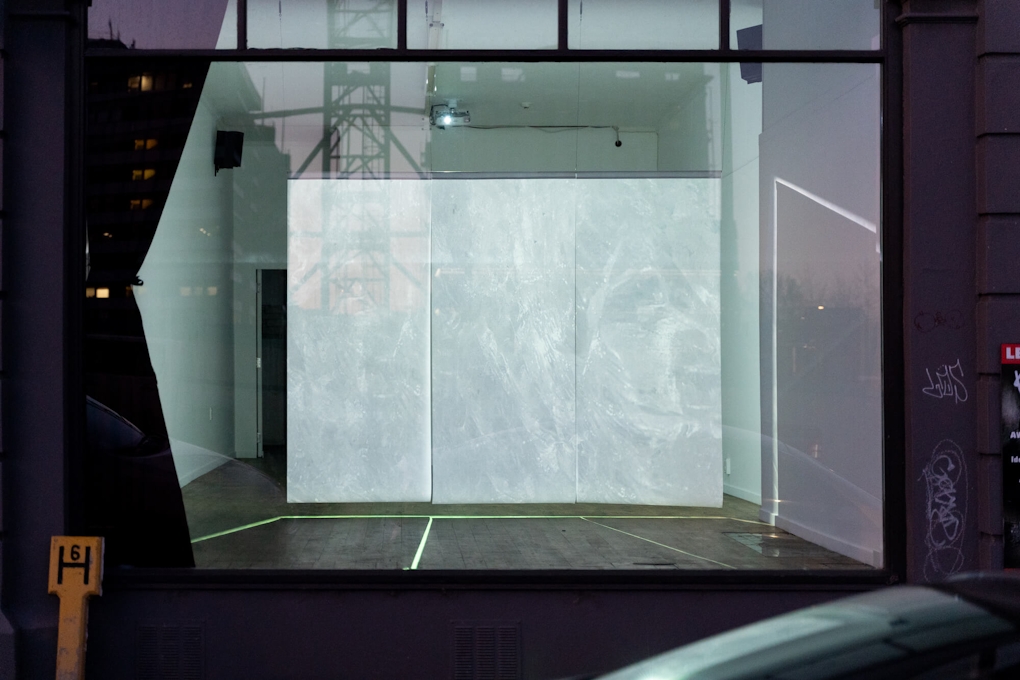
Installation view, Ron Bull, Stefan Marks, Janine Randerson, Rachel Shearer, Heather Purdie, Ngā raraunga o te Mākū: te hā o Haupapa (2023). Two-channel video, four-channel audio, custom software, live data feed courtesy of NIWA Taihoro Nukurangi, paper, recycled aluminium. Photo: Rosa Nevison.
A definition
If you have stood at the edge of Lake Pukaki near Aoraki, you might know that the milky ice-melt water body occupies a wide path created by a long-ago glacial ancestor. The glacier that pressed against the land on all sides and carved deep into the earth’s surface was once a thick, slow-moving river of compacted ice. Forming above the permanent snow line, snow on snow that survived any summer melt became firn—a middling state between snow and ice.(6) Firn that released air and acquiesced to compaction became glacier ice. Historically, and lingering yet at 416.14ppm CO2, the compacted ice river followed gravity and inched down the mountain. The snow melt from Haupapa Tasman glacier eventually flows into the sea via the Waitaki river just north of Ōamaru. Those who do not melt or can freeze again in the hukapapa of Aoraki remain part of the glacier, or Aoraki’s exhalation.
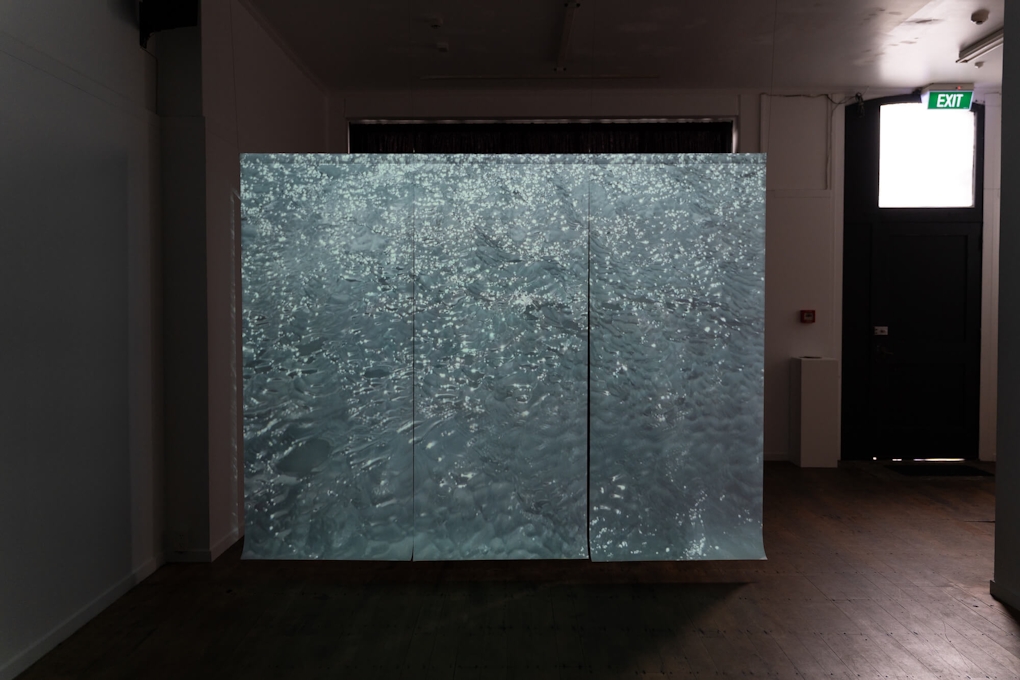
Ron Bull, Stefan Marks, Janine Randerson, Rachel Shearer, Heather Purdie, Ngā raraunga o te Mākū: te hā o Haupapa (2023). Two-channel video, four-channel audio, custom software, live data feed courtesy of NIWA Taihoro Nukurangi, paper, recycled aluminium. Photo: Rosa Nevison.
An event 11/02/2023
Ice chunks the size of skyscrapers break off New Zealand's Tasman Glacier(7)
[the fresh water melt of glaciers meets the salt water of oceans, who rise in response]
[as part of the 1998 Ngāi Tahu Treaty settlement, the dual name of Haupapa Tasman Glacier was ratified in 2013]
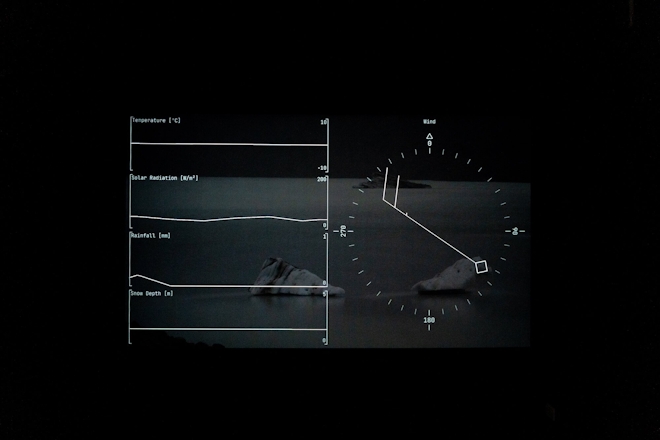
Ron Bull, Stefan Marks, Janine Randerson, Rachel Shearer, Heather Purdie, Ngā raraunga o te Mākū: te hā o Haupapa (2023). Two-channel video, four-channel audio, custom software, live data feed courtesy of NIWA Taihoro Nukurangi, paper, recycled aluminium. Photo: Rosa Nevison.
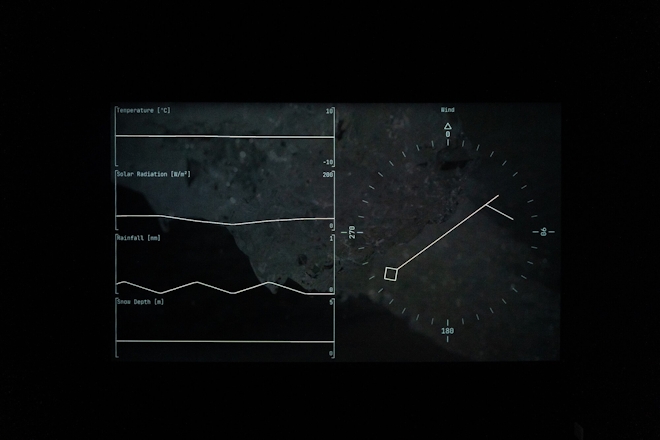
Ron Bull, Stefan Marks, Janine Randerson, Rachel Shearer, Heather Purdie, Ngā raraunga o te Mākū: te hā o Haupapa (2023). Two-channel video, four-channel audio, custom software, live data feed courtesy of NIWA Taihoro Nukurangi, paper, recycled aluminium. Photo: Rosa Nevison.
Breath
The breath of the wind on that day, the knife chill of that gale two hundred years ago, the exhalation of Aoraki, the bubbles in firn who release themselves into air, the inhalations of mana whenua travelling from one rohe to another, last week’s southerly that spun the weather gauge, the sharp inhale of Pancho Saucedo who witnessed February’s calving event at Haupapa, the haze of summer insects, the movement of an image across three oversized sheets of paper—blown by the wind, Tāwhirimātea’s bidding, Ron Bull’s annunciations of elemental beings on the newly formed (since the 1980s) Haupapa lake, the untethered rush of five-hundred-year old winds as warm air causes the glacier to shard, you in the gallery watching Tāwhirimātea’s breath determine whether footage from Haupapa will pan right to left, or left to right.
During the artist talk for the exhibition Ngā raraunga o te Mākū: te hā o Haupapa (The data of moisture, the breath of Haupapa) at Blue Oyster art project space on 15 September 2023, contributing artist, Kāi Tahu mātauranga knowledge-holder, and linguist Ron Bull said, "The breath is not given; it is taken." This koan-like statement was the utterance that has stayed with me, perhaps because it captures the ethical abyss of greed, extractivism, and ongoing racism towards mana whenua and other beings.
When the ice cracked, when the colds winds and moisture that formed the glacier hundreds of years ago exhaled and commingled with the last year’s air, the cracking and exhaling were not given, they were taken. As we know, they were taken by the greed of empire(s) and the greed of corporations.
As I began the research to write this response, another koan came to hold space alongside Bull’s ethical statement; the title of a downloaded book: "What we owe to each other."(8) Together then, the breath is not given; it is taken and what we owe to each other activate the dynamic of reciprocity. At Haupapa, Bull offered karakia and the taoka of ancestral names for the elements to acknowledge and honour the ātua, mauri, and whakapapa that connect ancestors, life forces of different beings, and relationships of belonging and responsibility. In a similar vein, the exhibition Ngā raraunga o te Mākū: te hā o Haupapa is also conceived as an offering and perhaps a wero, a challenge.
Timed to coincide with the closing of the exhibition on 28 October 2023, the artists posted on @blueoysterdunedin, the host gallery’s Instagram, acknowledgments to elemental ancestors, Haupapa, and specifically to the awa who generated the electricity that enabled, via hydroelectric processing, the moving images, sound recordings, and algorithms to be created, stored, and edited. In a familiar and not fully resolved refrain directed towards 'ecological art,' the materiality of devices and data, and the CO2 expended during the making, presentation, and dissemination of the works become as much a part of the discussion as its themes. Conscious of this, the posts include the following wero:
We call on the local councils, Crown and private sector to support restoration of Te Taiao to reciprocate the environmental costs of electrical energy flows.
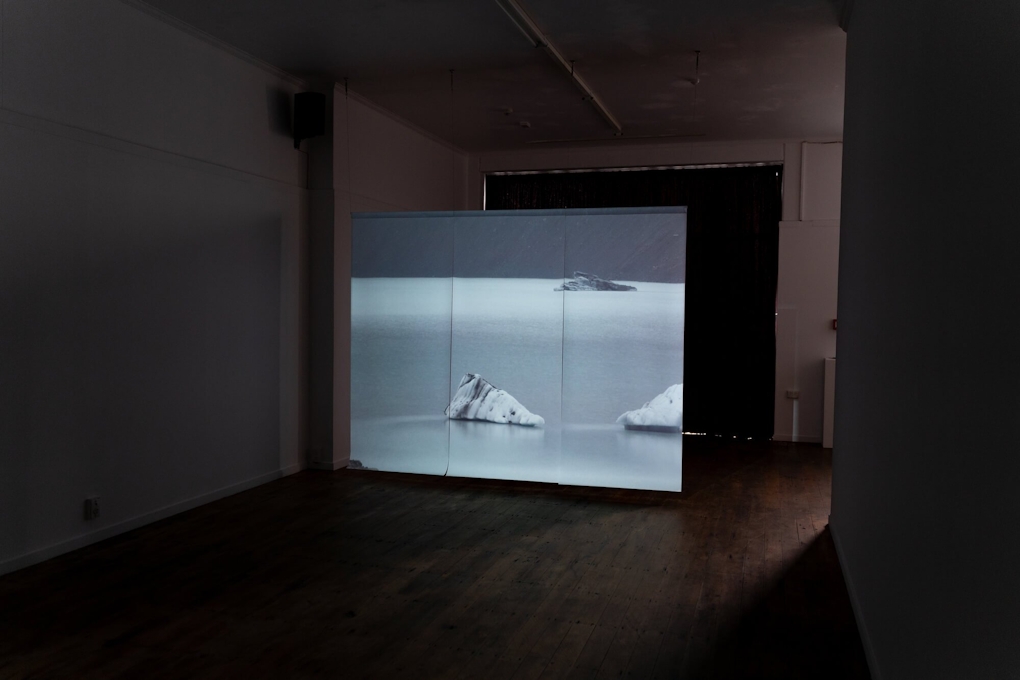
Ron Bull, Stefan Marks, Janine Randerson, Rachel Shearer, Heather Purdie, Ngā raraunga o te Mākū: te hā o Haupapa (2023). Two-channel video, four-channel audio, custom software, live data feed courtesy of NIWA Taihoro Nukurangi, paper, recycled aluminium. Photo: Rosa Nevison.
A phone call
On 27 October 2023, Ron and I had a kōrero about his koan of reciprocity and other kaupapa. During this kōrero, I experienced a lessening of the polarities that had previously occupied me when thinking about Ngā raraunga o te Mākū: te hā o Haupapa. I was particularly interested in the co-siting of western science, especially as it pertains to weather measurement, alongside Kāi Tahu mātauraka and/or mātauranga Māori. I listened to the kaupapa of Carol Brown and Tia Reihana-Morunga, who wrote:
The dominant ‘weather system’ as we know it, and as it is broadcast, quantified and measured, has evolved through instruments that were developed as part of the colonial project of European expansion.(9)
This is pertinent to Ngā raraunga o te Mākū: te hā o Haupapa, as the exhibition receives live streaming weather data from two village hut receptors at Mueller and Aoraki with the permission of NIWA Taihoro Nukurangi. If Tāwhirimātea is blowing from the south, the image pans towards the top; if the solar radiation is high, the moving images are bright and saturated; if the temperature falls below -5 degrees, the images predominately feature ice; if above +5 degrees, they feature water. The exhibition is constituted by the weather: wind including direction and strength, sun including degree of brilliance, precipitation including snowfall, temperature, as it is recorded by weather stations and streamed into the gallery. This weather data is algorithmically programmed to correspond with the type and temperature of Haupapa’s water body, and the movement and brilliance of images shot by Janine Randerson. NIWA’s meteorological data also programmes the selection of Rachel Shearer’s audio recordings at Haupapa and Bull’s utterances of the winds and elements.
By obtaining an understanding of Bull’s mātauraka practices of karakia and oriori at Haupapa and listening to him during our kōrero, I came to better understand the role of whakapapa and whakawhanaukataka or relationship building in relation to co-siting the practices of western science and mātauraka Māori. As with many exhibitions, the paracuratorial events and associated texts and kōrero complement the work in its purely visual and sonic dimensions.
Bull reiterated the politics of breathing, of reciprocity: if we are taking breath from the glacier, what are we giving?, and the kaupapa of "wider breathing"—which was like listening to a version of the journey of Primo Levi’s carbon atom in The Periodic Table. The effect was to experience Tāwhirimātea breathing from different directions across deep time and space, as the weather choreographed the visual and sonic components of the exhibition, and also to consider the origin of the huka breath that had come through earlier that October morning as blizzards of snow, swirls of hail stones, heavy rainfall followed by a saturation of sun had perhaps too cloaked and glanced off Haupapa.
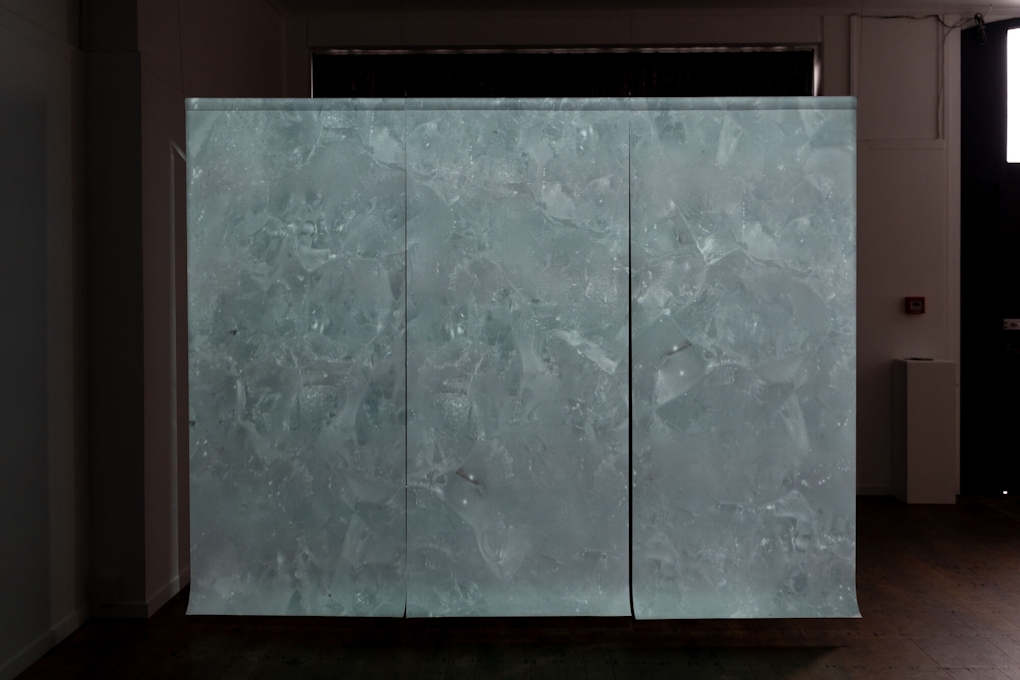
Ron Bull, Stefan Marks, Janine Randerson, Rachel Shearer, Heather Purdie, Ngā raraunga o te Mākū: te hā o Haupapa (2023). Two-channel video, four-channel audio, custom software, live data feed courtesy of NIWA Taihoro Nukurangi, paper, recycled aluminium. Photo: Rosa Nevison.
Air
Before and with the weather-algorithm-moving image and sonic installation, I wrote many adjectives related to the properties of elemental phenomena: to opacity, translucency, to the transmutation between liquid and solid states and the in between-ness existing simultaneously as flowing water, as firn bubbles, as solid wind-moisture formations that clanked, or ran smoothly against one another.
I wondered about another well-worn polarity, that of beauty and the call to action, and remembered that at this stage of climactic unfolding we need awe and awe-poignancy as much as any other approach. But perhaps not only beauty? Beauty with intention? Beauty born of kawa, recognition of ātua and mauri, a deepening understanding of whakapapa and practices of whakawhanaukataka with all beings. The kind of wero that accompanies the outstanding beauty of Haupapa, as offered by the artists in Ngā raraunga o te Mākū: te hā o Haupapa.
As the final line of the memorial to Okjökull reads: only you will know if you did it. Or as we might ask ourselves, here in the unfolding and the disaster and the grief and the recognition of connections and responsibilities and in the desire to live in a world that fosters reparative healing: what is my gift to the other beings who sustain life on earth for all of us?
Ngā raraunga o te Mākū: te hā o Haupapa is a series of artworks by Ron Bull, Stefan Marks, Janine Randerson, Rachel Shearer, Heather Purdie. This iteration was on view at Blue Oyster Art Project Space in Ōtepoti Dunedin from 15 September to 28 October 2023.
Robyn Maree Pickens is an art writer and poet who lives in Ōtepoti Dunedin with her kitten Pippin. She has a PhD in English (ecopoetics), a Masters in Art History, and is in the process of growing a food forest. Her first poetry collection, tung, was published by Otago University Press in August 2023.
